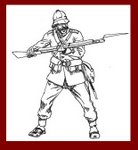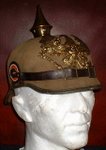
A Soldier's Companion Scenario fought at Origins '99
By Paul Westermeyer
Program Description
Space: 1889 in 1914! French and British Colonial troops use old, outdated equipment against German Colonial forces! Flying ships and Maxim Guns!This Origins '99 game was sponsored by HOT '99 (Historical Miniatures Gaming Society (HMGS) Origins Team).
Scenario Background:
My basic concept for Space: 1889 is that history moves forward in a very similar manner to the way it has advanced for us. Individual events change but the overall effect is the same. World War I thus comes about much as it did in our world, caused by diplomatic miscalculations and secret (and not very secret) alliance systems. Once begun, the war expands exponentially because of a 'use it or lose' attitude towards the mass armies formed in Europe, mobilization still being a very rough art.The early months of the war follow the same basic pattern as the historical event. Liftwood and hydrogen flyers engaged in the skies over Europe, but were not as overpowering as expected, much as in our history air power proponents proved extremely over-optimistic. The Royal Navy established a land and air blockade of Germany, but were unwilling to risk the Germans' formidable port and city defenses with either the Home Fleet or the Home Fleet's attached aerial squadron. The Germany army's invasion of France seemed destined to succeed but a desperate defense on the Marne coupled with a suicidal offensive by the French aerial forces halted their advanced and reduced war on the Western Front to the horrors of trench warfare.
One reason for this was that there were relatively few liftwood flyers. Despite popular expectations of a chemical alternative, none ever materialized. The aerial building race which began in the 1890s and continued into the first decade of the Twentieth century depleted the wild groves of liftwood dramatically. The High Martian tribes were easily subdued, and control of these strategic groves soon rested with the Earth powers and the more powerful Martian multi-city states (such as the Tossian Empire or Oenotrian Empire). Despite this, the yield of liftwood began to dramatically decline, and was most often used for ether flyers and vessels on Mars. This spurred the development of heavier-than-air powered craft, and the Wright Brothers still made their famous Kitty Hawk flight.
During the Great War Mars had several theaters, similar in many ways to the Levant and Africa on Earth. The British fought a savage battle with the Oenotrians along their colony's southern frontier, much like the one fought by Allenby against the Turks. In the north, and the rest of the planet, however, the British, French, and Japanese raced to capture as many of Germany's weakly held colonial possessions as possible, knowing that they would likely get to keep the territory they seized.
This scenario revolves around just such a German installation. A rail hub in Dioscuria (the Germans had installed a rail line to compensate for the dry canals of the region) is the shipping point for liftwood from the German groves. The allied power which seizes this hub will have access to one of the richest remaining sources of liftwood. A combined French, Japanese, and British squadron has flown to assault this well defended little town, but cooperation among the three is poor. Each national commander intends to have the honor of taking the town, and establishing his country's claim to it.
Victory Conditions:
German: To win, the German player must simply hold the town against the allies.Allies: Only one of the three allied groups can actually win the game. The player whose troops are the first to enter the town and remain will win, provided they have taken fewer then 50 percent casualties. If all of the allies have taken greater then 50 percent casualties then the player with the least casualties wins. Allied players may not fire on each other but are not required to aid each other either.
Order of Battle
The British Force:Maj Reginald Fiske, (Ldr 3), Royal Marines
"A" Company, Royal Marines CO: Major Reginald Fiske (Ldr 3)
Troop Value: V1 Bolt Action Rifles Dice 2:1 Range 16/32
"B" Company, Royal Marines CO: Major Brad Dyfed (Ldr 1)
Troop Value: V1 Bolt Action Rifles Dice 2:1 Range 16/32
"A" Company, 2nd Bn, Parhoon Rifles CO: Major John Tobold (Ldr 2)
Troop Value: V3S Bolt Action Rifles Dice 2:1 Range 24/48
HMS Hydra Armored Aerial Steam Launch CO:Lt Buller,RN (Ldr1)
Sailors UV:XO Nordenfeldt 3 Barrel MG Dice 3, RNG 24/48
HMS Perseus Armored Aerial steam launch CO:Lt Bolitho, RN (Ldr3)
Sailors UV:X0 Nordenfeldt 3 Barrel MG Dice 3, RNG 24/48
Plus Two Aphid-Class Aerial Gunboats, the Ladybug and the Aphid, and one DH-2 aircraft
The French Force:
Col Leboef (Ldr 3), Foreign Legion
"A" Company, Foreign Legion CO: Major LePeu (Ldr 3)
Troop Value: E2 Bolt Action Rifles Dice 2:1 Range 16/32
"B" Company, Foreign Legion CO: Major Renier (Ldr 1)
Troop Value: E2 Bolt Action Rifles Dice 2:1 Range 16/32
3 Sections, Field Artillery CO: Major Trechau (Ldr 1)
Troop Value: V0 Bolt Action Rifles Dice 2:1 Range 16/32
75mm Gun Pen 4/2 DV 3 ROF 2 Rng 4/8
Plus Two Warm Winds-class kites
The Japanese Force:
Col Yamamoto, (Ldr 3) 23rd Infantry Regiment
"A" Company, 23rd Infantry Regiment CO: Major Udo (Ldr 3)
Troop Value: V2 Bolt Action Rifles Dice 2:1 Range 16/32
"B" Company, 23rd Infantry Regiment CO: Major Toshu (Ldr 1)
Troop Value: V2 Bolt Action Rifles Dice 2:1 Range 16/32
2 Sections, Machine Gun Artillery CO: Major Kuisho (Ldr 1)
Troop Value: V0 Bolt Action Rifles Dice 2:1 Range 16/32
Maxim Machine Guns Dice:6 Range:24/48
Plus One Transport Kite (based on the Warm Winds design)
The German Force:
Col Schweiner, (Ldr 3) 12th Prussian
"A" Company, 12th Prussian CO: Major Kohl (Ldr 3)
Troop Value: V1 Bolt Action Rifles Dice 2:1 Range 16/32
"B" Company, 12th Prussian CO: Major Trantz (Ldr 1)
Troop Value: V1 Bolt Action Rifles Dice 2:1 Range 16/32
"A" Company, Wurtemburg Jaegers CO: Major Oster (Ldr 2)
Troop Value: V3S Bolt Action Rifles Dice 2:1 Range 24/48
"C" Squadron, Guard Uhlans CO: Major Westermeyer (Ldr 2)
Troop Value: V1 Bolt Action Rifles Dice 2:1 Range 16/32
Schutztruppen, CO Captain Lieber (Ldr 1)
Troop Value V1 Bolt Action Rifles Dice 2:1 Range 16/32
2 Sections, Machine Gun Artillery CO: Major Boomhafer (Ldr 1)
Troop Value: V0 Bolt Action Rifles Dice 2:1 Range 16/32
Maxim Machine Guns Dice:6 Range:24/48
2 Sections, Field Artillery CO: Major Boomhafer (Ldr 1)
Troop Value: V0 Bolt Action Rifles Dice 2:1 Range 16/32
75mm Krupp Gun Pen 4/2 DV 3 ROF 2 Rng 4/8
Marienburg Armored Aerial Gunboat CO:Lt Kruller,RN (Ldr1)
Sailors UV:XO
105mm Krupp Gun Pen 4/2 DV 4 ROF 2 Rng 4/8
2x1pdr Pom-pom Pen 0/0 DV 1 ROF 4 Rng 2/4
2xMaxim Machine Guns Dice:6 Range:24/48
Plus 1 Taube aircraft.
Origins Battle Description
The Origins game started out with the Allied players failing to decide on a single plan beyond assigning each force a side of the German position -- the British would advance quickly from the north, the French from the east, and the Japanese from the west.The German players distributed their forces as best they could, placing their artillery in the blockhouses, and their infantry and machine guns in the trenches around the town. The cavalry and shutztruppen were placed in the center of the town in reserve. The jaegers were placed in the upper stories of the available buildings, where they would have the broadest arc of fire.
1st Phase
In the first phase of the battle the German gunbat and Taube took off the moment the Allied squadron was spotted, and rushed to engage them. The British chose to be aggressive right and took their flyers straight in at the German lines. While the British gunboats engaged the heavier Marienburg at close range, the steam launches landed on the railroad tracks and unloaded their Royal Marines.
The Japanese and French chose a more cautious approach. The Japanese circled far to the west, while the French dropped behind some hills and skirted low along the eastern flank.
2nd Phase
The Royal Marines suffered heavily from German machine gun and rifle fire, they were forced to take cover behind their grounded steam launches and were unable to advance. The Marienburg circled about as the British gunboats raked the exposed German cavalry with machine gun fire, destroying them. The Taube flew out over the desert and made a daring bombing attack against the Japanese transport, but the sturdy Japanese kite took the hit with barely a shudder. Meanwhile, the wily French had landed behind the hills on the eastern flank and disgorged their legionnaires and began unloading their seventy-fives.
3rd Phase
The survivors of one company of the Royal Marines were forced to flee over the western hills after their steam launch fled from the incredibly accurate German artillery fire. The others remained pinned, while the British gunboats continued to exchange fire with the Marienburg with both sides taking significant damage. On the east flank the Legionnaires advanced in skirmish order over the hills, but found the German troops on that flank fresh and ready to respond. In short order they were pinned under heavy fire. The Japanese made the boldest move, however, when they sent their transport directly into the center of the town, landing behind the German trenches.
4th Phase
The Germans tried desperately to shore up their defenses as the allies pressed from every end. Their infantry rushed to the landed Japanese flyer and attempted to keep the soldiers pinned on board. Meanwhile, the Marienburg again pushed on to the battlefield, firing its weapons as fast as possible at every target they could sight. The Taube tried a daring landing on the southern end of the battlefield, and replaced its used bomb.
The allied response was equally desperate. Sensing the battle had reached a turning point, the French set their seventy-fives to fire from the deck of one of their kites and landed the vessel between the hills where they began to fire on the German blockhouse and trench line. This fire took a heavy toll on the German defenders, diminishing their fire and allowing the Legionnaires to resume their advance. Meanwhile, the British gunboats succeeded in silencing the last of the Marienburg 's guns, leaving her weaponless.
Final Phase
The final outcome was now apparent, and the Allies prepared to administer the coup de grace. The Taube was rearmed, but even as it took off it was destroyed by machine gun fire from the British gunboats. The Marienburg's commander recognized that his vessel was no longer effective, and fled to the south (he eluded later Allied pursuit and the repaired Marienburg remained a thorn in the Allied side for two more years). The French fire on the eastern flank covered a general forward rush by the Legionnaires, who soon controlled the trenches and wire on that flank. Meanwhile, the Japanese made a series of bayonet charges off their vessel into the center of town. Clearing several buildings of German defenders, they ensconced themselves inside.
With Allied forces controlling the center of town, and advancing from the outside as well, two active British gunships above, and no hope of relief or reinforcement, the German commander bowed to the inevitable and surrendered his forces.
The Japanese player, Van Siegling, was chosen as the overall winner because the Japanese bold move broke the German defenses, which had been successful up to that point. The victory was not complete because the Marienburg escaped, however. On in all, it was a very enjoyable game!































3 comments:
This one sounded like fun to try...)
Well the plan was to run this setting from about 1880 to 1920. This would fall into that pretty well..)
Was the Commander of the Armored Aerial Gunboat Marienburg really Lt Kruller, RN?
What a cad! What a bounder!
We shall have Imperial agents bring him back so he can be executed in the Tower of London for treason!
Yours in a White Wine Sauce,
Tas
Post a Comment